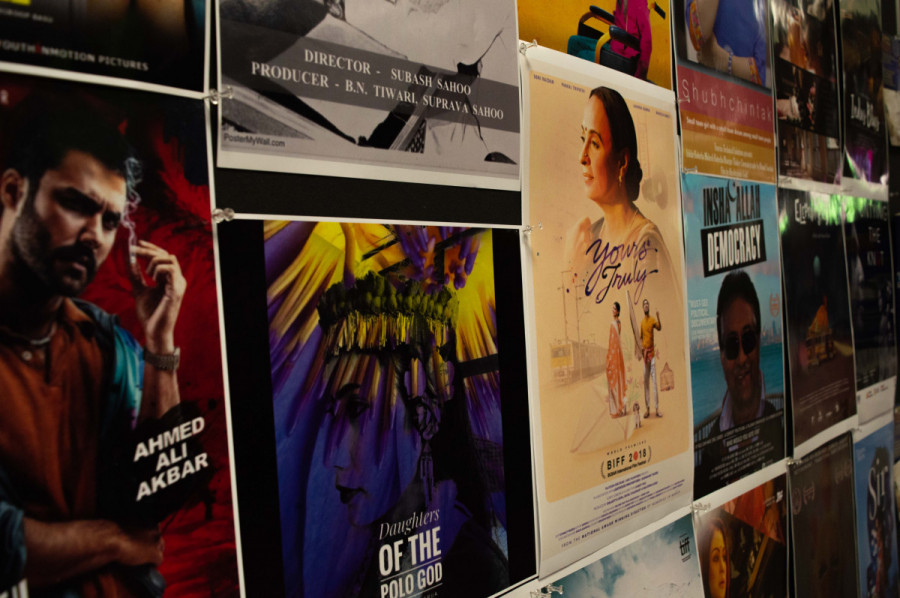Finding Sound in the Silence at the South Asian Film Festival
SAFF Is Headed to Saguenay After Successful Montreal Run
“It is this recorder that [Jyoti Milner] brought,” announced the South Asian Film Festival director Dipti Gupta holding up a 1970s tape recorder to show the theatre audience on Oct. 26. “This was a recorder that her father used to always use.”
The South Asian Film Festival is packing up. After a Montreal run, it’s leaving for Saguenay between Nov. 15 and 17.
Milner brought the recording device, and sat at the front of the audience that night to watch the feature-length documentary dedicated to her father, a legend in Indian cinema, Mangesh Desai.
“Where the film ends, Jyoti will continue,” said Gupta.
The audience filled the De Sève Cinema to watch The Soundman Mangesh Desai directed by Subash Sahoo—but first, a documentary short-film directed by Concordia alumnus Taimur Rahim opened the big screen, titled With Bells on Her Feet.
As a 15 minute short, With Bells on Her Feet follows the voice and story of classical dancer Sheema Kermani, who spoke about the time a dictator’s ascendancy restricted her from sharing her art in Pakistan.
“For me, there is a direct relationship between dance and liberation,” opened Kermani in the film, as she danced gloriously beneath the sunlight, catching the rhythm of the bells on her feet.
When Muhammad Zia-ul-Haq became head of state, he imposed strict laws that censured Kermani and others from performing the art of classical dance in public spaces.
RelatedKermani explained that, in Pakistan, dance continues to be synonymous with obscenity, even in the aftermath of those impositions, and the sudden death of the dictator in 1988.
“An entire generation in the 1980s grew up with ill-informed and convoluted ideas about dance,” she said.
“A common perception is that it’s meant solely for male titillation,” said Kermani. “In its purest form, classical dance is meant to relate stories in a beautiful and meaningful manner.”
According to Kermani, classical dance is often misunderstood in Pakistan.
“There are people who tell me that dance is not part of our culture,” she said, “Isn’t this strange, considering that the very first artefact related to dance was discovered on Pakistani soil?”
“If you just watched him closely to what he was looking at—his concentration—he is not necessarily listening to the sound: He is looking at the frequency that the sound makes in front of him.” — Jyoti Milner
She spoke of a 4000-years-old figurine carved as a dancing girl, a statue recovered from the archeological ruins of Mohenjo-daro.
For Kermani, dance became an act of defiance and resistance against authority and attitudes that continue to degrade the classical art.
She believes that the performing arts are essential in societies because those skills teach empathy, imagining what it’s like to be in someone else’s shoes.
“Pick up something, and give it to somebody,” said Kermani, coaching a class of young dancers. In the film, a student sways her hands with elegance to Kermani’s instruction, motioning them to give her gift.
Cupping her hands, Kermani commanded the class, “A beautiful full-bloomed flower—a bumblebee.” She elevated her wrist quickly to chase an imagined bumblebee, swirling her fingers in the air.
“So, you show a flower, and you can show the bumblebee on the flower—and it flies away like that,” Kermani said, with a swift motion of her wrist.
“Many girls who join my classes are initially very inhibited,” she explained. “Their chest is closed in; their shoulders are hunched in an attempt to hide their developing femininity.”
“But dance had to conquer such inhibitions,” said Kermani.
RelatedThe theatre turned black before it glowed again for the second film that night: The Soundman Mangesh Desai.
Throughout the feature-film, sound technicians, directors, and producers spoke of “the unsung hero,” of the “sound recordist,” the “genius.” The only voice that went unheard was Desai himself.
As a world-renowned sound mixing engineer, Desai gained reputation working the backroom of iconic Indian films. Both commercially and artistically, he created and edited sounds in contribution to the Bombay film industry.
Milner explained that the film industry reflected the noise of the culture, but that Desai embraced the silences in his soundscapes.
“He really believed in freedom for India,” said Milner.
When the film ended, Milner spoke about her father’s upbringing, his health problems, his imprisonment during British rule, and his relationship with her mother.

According to Milner, her father was more the family man than the ego-driven workaholic that was depicted on the screen.
“He had a reputation for being ill-tempered but he really wasn’t ill-tempered; he really cared,” she said. “He did not like to waste time. He was a perfectionist.”
Another characteristic of her father that was excluded in the film was his hearing loss.
“I probably inherited it from him. I have hearing aids,” said Milner.
“It dawned on me watching him,” said Milner about the documentary. “If you just watched him closely to what he was looking at—his concentration—he is not necessarily listening to the sound: He is looking at the frequency that the sound makes in front of him.”
The documentary assembled the voices of those who worked alongside Desai. They all expressed their admiration for his extreme focus and concentration.
Even though his body was thin and frail due to major health problems, he piloted everyone with authority inside the sound proof walls of the studio. Many expressed how they were too frightened to approach or bother the man.
“He knew the science really, really well,” said Milner. She explained that her father would read and study the manuals of the various equipment he would use to record sound even in his time of relaxation.
Milner said that even though her father was highly attentive with his work, he was not oblivious to what was happening in the home.
Related“I wish that the movie had been able to depict that in a much better way—and my mother,” she said.
“I don’t think he could’ve done what he did, nor accomplish what he did if it wasn’t for her,” Milner added.
“She gave him that quiet support,” Milner said, “and she was his quiet strength.”
Caricatures shown in the film exaggerated Desai’s need for perfection and for his strict temper in the sound engineering room. But, Milner remembers him being supportive of her and her endeavours as well.
“This tape recorder—he gave me this tape recorder because I was the only one of the three children who was remotely interested in doing sound mix,” said Milner holding the sound device in her hand. “I’ve had it all these years.”
“My father never liked to be in the limelight,” said Milner. “To him, it was just a job.”


_600_832_s.png)

